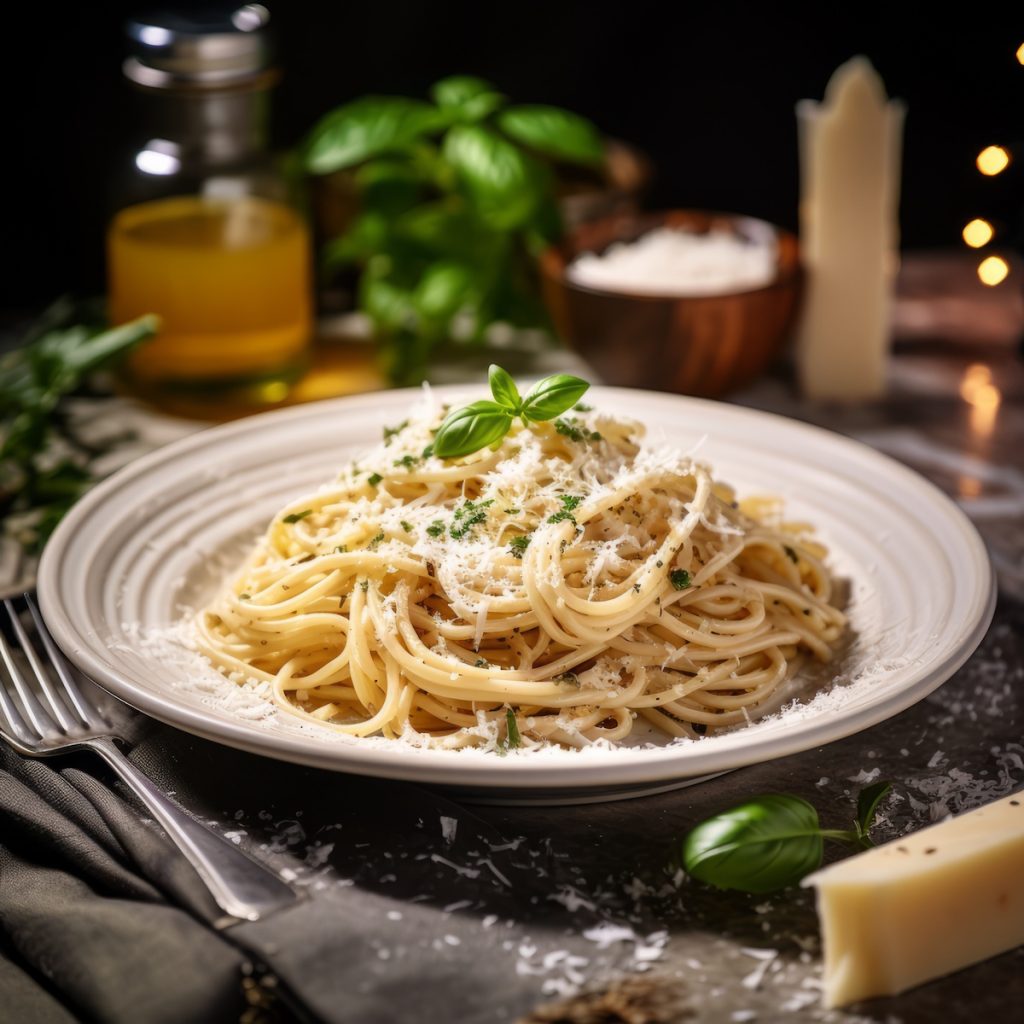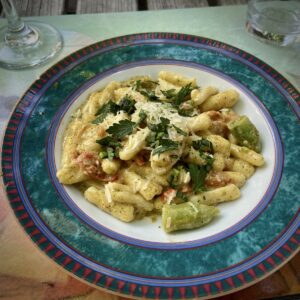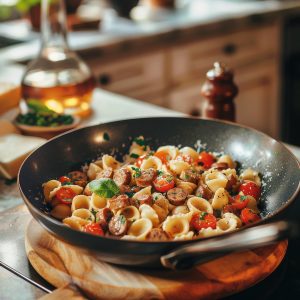What Is Cacio e Pepe?
Cacio e Pepe, a classic Italian pasta dish, exemplifies the beauty of simplicity and the art of using a few high-quality ingredients to create a culinary masterpiece. With its origins deeply rooted in Rome, this iconic dish has been enjoyed for centuries, gaining popularity beyond the confines of Italy and captivating the palates of food enthusiasts worldwide.
The name “Cacio e Pepe” translates to “cheese and pepper” in English, which reveals the essence of this delectable pasta creation. The dish has three primary ingredients: pasta, Pecorino Romano cheese, and freshly ground black pepper. Yet, when combined skillfully, these components produce a symphony of flavors that satisfy diners utterly.
Here’s how you pronounce cacio e pepe – (kaa chee ow ee peh pay).
Ingredients
The star of Cacio e Pepe is undoubtedly the Pecorino Romano cheese. This cheese, made from sheep’s milk, hails from the regions of Lazio and Sardinia in Italy. Its distinct sharp and salty taste brings depth and richness to the dish. The cheese is typically grated or shaved, allowing it to blend seamlessly with the pasta while creating a luscious, creamy sauce.
Freshly ground black pepper is the second protagonist in this culinary masterpiece. The pepper not only adds a gentle kick of heat but also enhances the flavors of the Pecorino Romano, striking a harmonious balance between the cheese’s saltiness and the peppery zing.
The pasta component is equally vital. Traditionally, Cacio e Pepe is made with long, thin strands of pasta such as tonnarelli or spaghetti. These pasta varieties offer the ideal texture and surface area to hold the cheese and pepper sauce, ensuring that each bite is infused with a delightful combination of flavors.
Preparation
The preparation of Cacio e Pepe is an art form that demands skill and finesse. Achieving the perfect creamy consistency for the sauce while avoiding cheese clumps requires technique and practice. The pasta is first cooked until al dente, preserving its firmness and texture. Meanwhile, a generous amount of black pepper is toasted in a pan to release its aromatic oils, infusing the dish with its characteristic fragrance.
The cooked pasta is transferred directly to the pan with the pepper, and a small amount of pasta water is added to create a starchy base for the sauce. The real magic happens when the finely grated Pecorino Romano is gradually sprinkled into the pan, with constant stirring, to ensure a smooth, velvety pasta coating. The result is a glossy, flavorful sauce that clings lovingly to each strand of pasta, creating a delightful medley of taste and texture in every mouthful.
Cacio e Pepe’s enduring appeal lies in its straightforward yet sophisticated character. It exemplifies the heart of Italian cuisine: honoring and celebrating the essence of the ingredients without overpowering them with unnecessary complexity.
This timeless dish showcases the culinary prowess of the Italian culture, emphasizing that the best dishes are often crafted from simple, high-quality components.
As Cacio e Pepe continues to enchant diners across the globe, its legacy endures as a testament to the power of tradition, authenticity, and the brilliance of simplicity in the world of gastronomy. Whether enjoyed in a bustling trattoria in Rome or prepared with love in the kitchen of an adventurous home cook, this classic Italian delight remains a true gem in the world of pasta dishes.

Cacio e Pepe History
The history of Cacio e Pepe is deeply intertwined with the culinary heritage of Rome, Italy. While there isn’t a precise date or documented origin of the dish, it is believed to have ancient roots, tracing back centuries to a time when pasta was becoming a staple in the Italian diet.
One theory suggests that Cacio e Pepe was a dish popular among shepherds in the pastoral regions of Lazio, where Rome is located. The dish’s simplicity and few ingredients make it well-suited for a shepherd’s lifestyle, as they could easily carry and prepare the components during their journeys with their herds.
The name “Cacio e Pepe” itself indicates a rustic and straightforward nature, as “Cacio” refers to “cheese” in various Italian dialects, particularly Pecorino Romano, which has been produced in the region for centuries. “Pepe” means “pepper,” and it’s the other main ingredient that gives the dish its characteristic flavor.
Shepherds likely carried dried pasta, Pecorino Romano cheese, and dried pepper, an essential spice used in Italian cuisine since ancient times. Combining these three ingredients cooked over an open flame or simple campfire would have yielded a comforting and nourishing meal for the shepherds during their journeys.
Over the centuries, as Rome developed into a cultural and culinary hub, Cacio e Pepe made its way from the countryside into the city’s bustling trattorias and osterias. It became a popular dish among locals and travelers alike, beloved for its simplicity and exquisite taste. In Rome, Cacio e Pepe is considered one of the traditional “four classic Roman pasta dishes,” along with Carbonara, Amatriciana, and Gricia.
Gaining Popularity
As the dish gained recognition beyond Italy’s borders, it found its way onto menus in Italian restaurants worldwide. Today, Cacio e Pepe continues to be celebrated as a timeless classic in Italian cuisine, and chefs worldwide try to recreate its authentic flavor and texture.
The preparation of Cacio e Pepe has remained largely unchanged throughout history. The techniques passed down through generations of Italian cooks continue to emphasize the importance of quality ingredients, careful timing, and skilled blending to achieve the perfect balance of flavors and signature creamy sauce.
While the dish’s origins are humble and tied to the rural landscapes of Italy, Cacio e Pepe has evolved into a culinary symbol that embodies the essence of Italian cooking—wherein simplicity and reverence for high-quality ingredients lead to unforgettable flavors. It is a dish that pays homage to the past while captivating modern food enthusiasts with its timeless appeal. Whether enjoyed in the historic streets of Rome or in a contemporary bistro halfway across the world, Cacio e Pepe remains a cherished icon of Italian gastronomy.
Five Fun Facts about Cacio e Pepe
Cacio e Pepe is believed to have ancient origins, with some food historians speculating that it may date back to the Roman Empire. Its simple combination of pasta, cheese, and pepper makes it a dish that could have been enjoyed by ancient Roman shepherds or soldiers due to its easy preparation and portability.
Historically, Cacio e Pepe was considered a “poor man’s dish” due to its humble ingredients and affordability. Pecorino Romano cheese, made from sheep’s milk, was more accessible and cheaper than other types of cheeses, making it a popular choice among the lower classes in ancient Rome.
One of the key secrets to achieving the creamy and luscious sauce in Cacio e Pepe lies in the pasta water. The starchy water from boiling the pasta is added to the pan while preparing the sauce. The pasta water, cheese, and pepper combine to create an emulsified sauce that coats the pasta evenly, resulting in a rich and velvety texture.
Cacio e Pepe is deeply rooted in Roman culinary tradition. It is considered one of the classic dishes of Roman cuisine, alongside Carbonara, Amatriciana, and Gricia. When visiting Rome, locals and tourists alike seek out authentic versions of these pasta dishes in traditional trattorias to experience the true flavors of the city.
This beloved pasta dish has gained such popularity that it now has its own dedicated day of celebration. In recent years, January 19th has been unofficially recognized as “Cacio e Pepe Day” in some food circles, with pasta enthusiasts and chefs celebrating the dish’s simplicity and deliciousness on this special occasion.

What To Serve With Cacio e Pepe?
Cacio e Pepe is a flavorful and rich pasta dish that can be enjoyed on its own, but it can also be complemented with various accompaniments to create a well-rounded meal. When serving Cacio e Pepe, consider these delicious side dishes to enhance the dining experience:
- A fresh and crisp salad can provide a refreshing contrast to the richness of Cacio e Pepe. Opt for a light green salad with mixed greens, cherry tomatoes, cucumbers, and a tangy vinaigrette dressing. The salad’s vibrant colors and flavors will balance out the creamy and savory pasta.
- Grilled vegetables offer a delightful charred taste and add a touch of smokiness to the meal. Zucchini, bell peppers, eggplant, and asparagus are excellent choices. Toss the vegetables in olive oil, sprinkle with salt and pepper, and grill them until tender and slightly caramelized.
- A classic accompaniment to any pasta dish, garlic bread is a crowd-pleaser that complements the flavors of Cacio e Pepe. Spread a mixture of butter, minced garlic, and parsley on sliced baguette or Italian bread, then toast them in the oven until golden and crispy.
- An antipasti platter filled with an assortment of cured meats, olives, marinated vegetables, and cheeses adds delightful flavors and textures to the meal. It’s a perfect option for those who enjoy a variety of tastes alongside their pasta.
- For those looking to add protein to the meal, consider serving Cacio e Pepe with roasted chicken or grilled shrimp. The tender and succulent meat complements the pasta dish and offers a hearty and satisfying meal option.
- To elevate the dining experience, consider pairing Cacio e Pepe with a suitable Italian wine. A light and crisp white wine like Pinot Grigio or a medium-bodied red wine like Chianti Classico can complement the pasta’s flavors beautifully.
Remember that Cacio e Pepe shines in its simplicity, so the side dishes should not overpower the dish but rather enhance its flavors. The key is to provide complementary tastes and textures that create a well-balanced and enjoyable meal. Whether you choose a light salad, grilled vegetables, or a delectable antipasti platter, these side dishes will enhance the dining experience and make your Cacio e Pepe meal truly memorable.
Cacio e Pepe
Ingredients
- 14 ounces of long, thin pasta spaghetti or tonnarelli
- 1 cup Pecorino Romano cheese freshly grated
- 1 tablespoon black pepper freshly ground
- salt for pasta water
- olive oil Extra Virgin (optional)
Instructions
- Bring a large pot of salted water to a boil. Add the pasta and cook according to the package instructions until it's al dente. Remember to reserve about 1 cup of the pasta water before draining the pasta.
- While the pasta cooks, toast the freshly ground black pepper in a dry pan over medium heat for 1-2 minutes until aromatic. This will enhance its flavor.
- Once the pasta is cooked, drain it and transfer it back to the pot or a large sauté pan. Add a drizzle of extra virgin olive oil (optional) to prevent the pasta from sticking together.
- Immediately sprinkle half of the grated Pecorino Romano cheese and half of the toasted black pepper over the pasta. Toss the pasta vigorously, allowing the cheese to melt and coat the pasta strands evenly.
- Gradually add the remaining Pecorino Romano cheese and black pepper, tossing continuously. If the sauce seems too thick, add a splash of the reserved pasta water and continue tossing until you achieve a creamy and glossy consistency.
- Taste the pasta and adjust the seasoning, adding salt if needed (remember that Pecorino Romano is naturally salty, so be cautious with additional salt).
- Serve the Cacio e Pepe immediately while it's hot and at its best. Garnish with a sprinkle of black pepper and some extra grated Pecorino Romano cheese if desired.
- Enjoy!
















